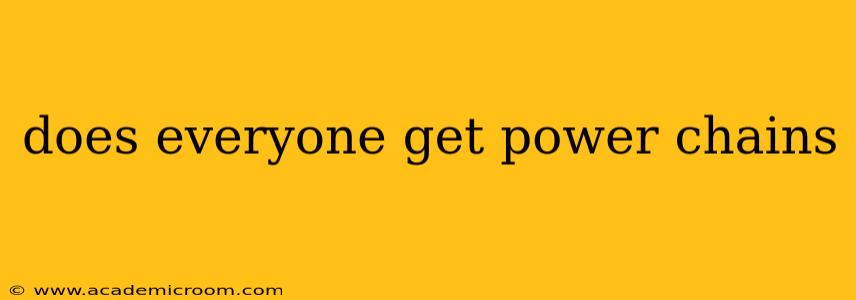Does Everyone Get Power Chains? Unpacking the Reality of Power Chains in Dentistry
The question, "Does everyone get power chains?" is a common one among those facing orthodontic treatment. The short answer is: no, not everyone needs or receives power chains. Their use depends entirely on individual needs and the specific treatment plan designed by an orthodontist.
Let's dive deeper into understanding power chains and why they're not a universal part of orthodontic treatment.
What are Power Chains?
Power chains are small, elastic chains used in orthodontics. They're typically made of a flexible, durable material and are placed around brackets to apply gentle, continuous force to move teeth. This force helps close gaps between teeth, align crowded teeth, and rotate teeth into the proper position. They come in various strengths and colors, allowing orthodontists to tailor the treatment to individual needs.
Why Don't All Orthodontic Patients Need Power Chains?
The decision to use power chains is based on several factors, including:
- The complexity of the orthodontic case: Simple cases involving only minor crowding or spacing may not require power chains. More complex cases with significant crowding, gaps, or rotational issues often benefit from their use.
- The type of braces: While common with traditional metal braces, power chains might not be necessary with other systems like Invisalign or lingual braces. The mechanics of these alternative systems often achieve similar results through different methods.
- The individual's tooth movement requirements: Some patients require specific tooth movements that are best achieved with power chains, while others may respond well to other techniques.
- The orthodontist's preferences: Ultimately, the orthodontist's expertise and experience play a significant role in determining the most effective treatment plan, including the use of power chains.
What are the Alternatives to Power Chains?
If power chains aren't deemed necessary, orthodontists might employ alternative methods to achieve similar results. These might include:
- Individual elastics: Small rubber bands used to connect specific teeth and apply targeted force.
- Springs: Small metal springs placed between brackets to gently push or pull teeth.
- Other specialized orthodontic appliances: There are various orthodontic appliances designed for specific situations that can help align teeth effectively.
How Do I Know if I'll Need Power Chains?
The only way to know if you'll need power chains is to consult with an orthodontist. They will conduct a thorough examination, assess your teeth alignment and bite, and discuss your treatment options. During your initial consultation, they'll explain the proposed treatment plan, including the use of any specific orthodontic appliances, such as power chains. Open communication with your orthodontist is key to understanding the specifics of your treatment.
Are Power Chains Painful?
The initial application of power chains might cause some slight discomfort, similar to the feeling of tightening braces. However, this discomfort is typically temporary and manageable with over-the-counter pain relievers.
How Long Are Power Chains Used?
The duration of power chain use varies depending on the individual's treatment plan and the complexity of their case. It could range from a few weeks to several months. Your orthodontist will monitor your progress and adjust the chains or replace them as needed.
In conclusion, while power chains are a valuable tool in orthodontics, they're not a universal requirement. The decision to use them is made on a case-by-case basis, tailored to individual needs and the overall treatment plan developed by your orthodontist. Always consult with a qualified professional for personalized guidance on your orthodontic care.
